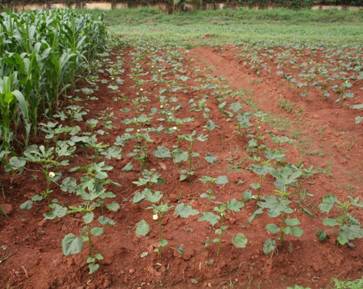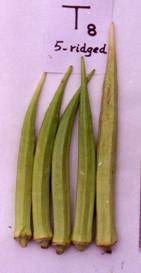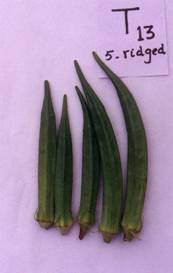
Crop: Okra
Scientific name : Abelmoschus esculentus (Lin.)
Common / Local Name : Lady’s Finger/Bhendi (Konkani)

Okra is predominantly a crop of tropics and sub tropics. It occupies fifth position, next to tomato in area under vegetables in the country. The crop is cultivated for its young tender fruits used in curry and soups after cooking. It is good source of vitamins A and B, protein and minerals. It is an excellent source of iodine and is useful for the treatment of goitre.
Field should be ploughed thoroughly for 2-3 times for making soil to a fine tilth. Ridges and furrows or raised beds are prepared and seeds are sown by dibbling on sides of ridges or on raised beds. Soak seeds for 6-12 houses before sowing to enhance germination during summer
During summer, vegetative growth is relatively less and seeds are sown at a closer spacing of 45 x 20 cm or even less. Seed rate required is 18-20 kg/ha. During kharif, plant grows vigorously with more branching and seeds are sown at wider spacing of 60 x 30 cm for branching types and 45 x 30 cm for non branching types. Seed rate recommended for kharif is 8-10 kg/ha.
Bhindi varieties and cultivars differ in growth habit, height of plants, presence of purple pigmentation of plant parts, length, colour and number of ridges of fruit etc.
Arka Anamika: Resistant to YVM, fruits five ridges, green medium long. Yield: 11.5 t/ha..
Parbhani Kranti: Fruits five ridged, dark green, medium long. Yield: 9-11 t/ha..


Application of 20tonnes of FYM and a dose of 150 kg each of N, P2O5 and K2O is recommended for Pusa Sawani in the coordinated trials. One third dose of N, full P and K are to be applied as basal dose. Remaining N has to be applied in two split doses, 4 weeks after sowing and at flowering and fruiting stages. Split application of N in soil at every 3rd picking is advantageous for getting high yield, for increasing number of harvests and to maintain size of fruits towards last harvests.
Water stress at flowering and fruiting stages will drastically influence growth of plants, size of fruits and yield. Immediately after sowing field is irrigated. Subsequent irrigation is given at fixed intervals depending on texture of soil and climate.
Weed growth should be under control till crop canopy covers fully. This is achieved by frequent hoeing, weeding and earthing up. Use of weedicides like Lasso (2 kg a.i./ha) or fluchloralin (1.5kg/ha) or Metolachlor (1.0kg a.i./ha) and one hand weeding at 45 days after sowing way very effective and financially viable under All India co-ordinated trials
Yellow Vein Mosaic (YVM):
Fruit borer:
Harvests fruits when they attain maximum size but still tender. Fruits of 6-8cm long are preferred for export purposes. This is usually attained by 5-6 days after opening of flower. Harvesting is done in alternate days with a knife or by bending pedicel with a jerk. For harvesting, cotton cloth hand gloves should be used to protect fingers from stinging effect. It is advisable to harvest in morning hours since fruit hairs will be soft. Sprinkling water on pods during night will keep them cool and fresh for market.
Yield: 6-8 t/ha for summer crop
10-12 t/ha for kharif crop
Fruits after harvesting are graded and filled in jute bags or baskets or perforated paper cartons and sprinkled with water. Pre cooling of fruits before packing maintains turgidity of fruits and will save it from bruises, blemishes and blackening. This is usually done before packing fruits in perforated cartons of 5-8 kg before transporting to refrigerated van for export.
Input availability |
Address/Contact details |
| Seeds | IDepartment of Agriculture, Panaji, ICAR-CCARI, Old Goa, KAU, Thrissur, Kerala, OUAT, Bhubaneswar and IIHR, Bangalore |
Fertilizers |
For detailed list kindly click here |
Pesticides |
For detailed list kindly click here |
| Machineries | Department of Agriculture, Panaji, Goa tractors and Tillers, Mapusa |
|